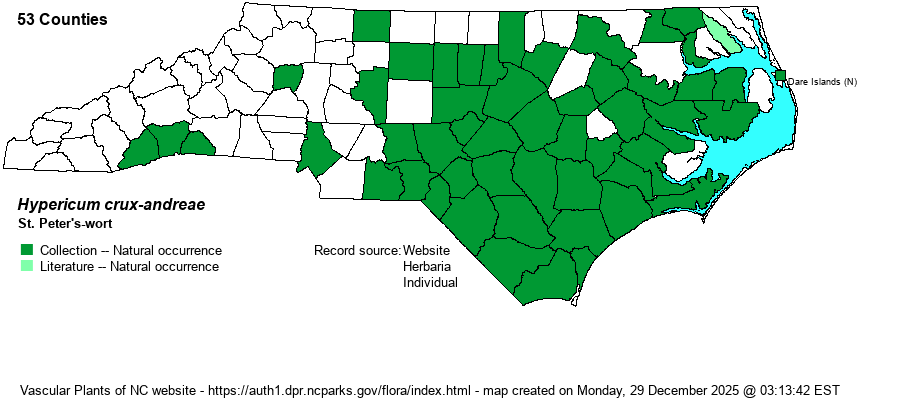| Section 6 » Order Theales » Family Hypericaceae |
Show/Hide Synonym
| taxonName | relationship | relatedTaxonName | relatedTaxonRefText | relComments |
|---|
|
|
|
|
|
|
|
|
|
|
| Hypericum crux-andreae | = | Hypericum stans | Gleason and Cronquist (1991) | | | Hypericum crux-andreae | = | Hypericum stans | Radford, Ahles, and Bell (1968) | | | Hypericum crux-andreae | = | Hypericum stans | Stevens in Kubitzki, Bayer, & Stevens (2007). Key based in part on Adams (1973), Godfrey (1988), C, and GW. {add for FL: Hyperi | | | Hypericum crux-andreae | = | Hypericum stans | Stevens in Kubitzki, Bayer, & Stevens (2007). Key based in part on Adams (1973), Godfrey (1988), C, and GW. {add for FL: Hyperi | | | Hypericum crux-andreae | = | Ascyrum stans | Fernald (1950) | | | Hypericum crux-andreae | = | Ascyrum stans | Gleason (1952) | | | Hypericum crux-andreae | > | Ascyrum stans | Small (1933, 1938) | | | Hypericum crux-andreae | > | Ascyrum cuneifolium | Small (1933, 1938) | | | Source: Weakley's Flora |
|
| Author | (L.) Crantz | |
| Distribution | Throughout the Coastal Plain and into the eastern third of the Piedmont; widely scattered over the remainder of the state, including in the southern Mountains. Absent from most of the Mountains.
This is primarily a Coastal Plain species, but is found across much of the Southeast, ranging north to Long Island, NY, and south to southern FL and eastern TX.
| |
| Abundance | Frequent to common in most of the Coastal Plain, fairly common in the far eastern Piedmont; generally rare in most of the remainder of the Piedmont and southern Mountains. | |
| Habitat | This species has a wide array of habitats and is not characteristic of any particular ones. It is most often found in pine dominated flatwoods and drier savannas, but it can be found in ditches, seepages, as well as in slightly drier upland forests, particularly in sandier areas under pines. It is not found in rocky sites or growing in hardwood forests. | |
| Phenology | It has a wide spread of flowering dates, from June to October; fruits during that same period. | |
| Identification | This is a slender, short deciduous shrub with shreddy bark, growing only to 1-2 feet tall. It has only a few short branches toward the end of the stem, with opposite leaves that are variably shaped – mostly elliptic to obovate but with rounded tip and sessile/clasping bases. The leaves are only about 1-inch long, entire, and rather thick. Though the leaves and stem are not overly notable, it has a very distinctive flower. The 4-petaled yellow flowers have two very wide and rounded outer sepals and two very narrow inner ones, and thus the flat flower sits on very unequal-looking “bracts”, quite unique when seen from above. This is a species that is often encountered in the Coastal Plain, in such a wide array of conditions that most biologists would have a difficult time “dove-tailing” it into any particular habitats. | |
| Taxonomic Comments | Until fairly recently, it was named as Hypericum stans. Older references had this odd species in a different genus, and named as Ascyrum stans.
| |
| Other Common Name(s) | None, other than slight changes in spelling, hyphenation, etc. | |
| State Rank | S5 | |
| Global Rank | G5 | |
| State Status | | |
| US Status | | |
| USACE-agcp | FACW link |
| USACE-emp | FACU link |

